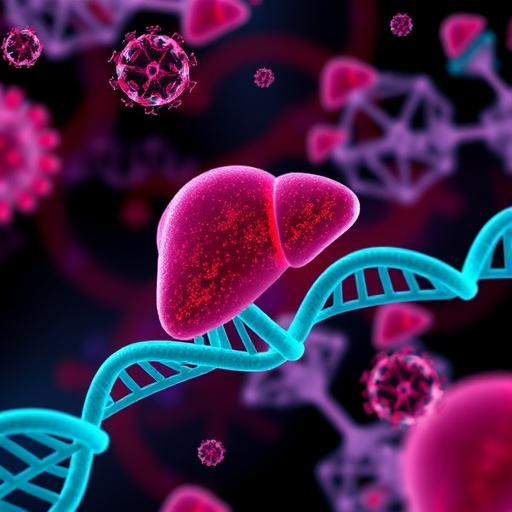In a groundbreaking advancement within the field of gene therapy, researchers have unveiled a potent enhancement in the delivery efficiency of lentiviral vectors targeting hepatocytes in vivo. The study, led by Canepari, Milani, Simoni, and colleagues, presents a transformative approach with profound implications for treating a variety of liver-associated genetic disorders. Published in Nature Communications in 2025, this research demonstrates a significant leap in the ability to manipulate gene expression within hepatocytes, the primary functional cells of the liver, which play a crucial role in metabolism, detoxification, and protein synthesis.
Lentiviral vectors are a category of viral vectors derived from lentiviruses, a subclass of retroviruses capable of integrating their genetic material stably into the host genome. These vectors are highly valued in gene therapy due to their ability to transduce non-dividing cells and mediate long-lasting gene expression. However, delivering these vectors efficiently and selectively to hepatocytes in vivo has long posed a formidable challenge. Traditional approaches often suffer from low transduction efficiency, off-target effects, and immunogenicity, limiting their clinical potential.
The team’s innovative enhancement revolves around optimizing both the lentiviral vector design and in vivo delivery protocols to circumvent these limitations. By systematically modifying the viral envelope proteins and refining vector dosing and administration routes, the researchers achieved unprecedented transduction efficiencies in hepatocytes while minimizing off-target transduction of other cell types. This stereochemical and tropism optimization is central to the vector’s success, as it improves selective binding and uptake by hepatocytes situated within the complex architecture of the liver sinusoidal environment.
One core advancement described involves engineering the viral envelope glycoproteins to boost their affinity for receptors uniquely expressed on hepatocytes. Leveraging recent insights into liver receptor biology, such as the asialoglycoprotein receptor (ASGPR) and other membrane markers, the team tailored the surface proteins of lentiviral particles to promote receptor-mediated endocytosis specifically in hepatocytes. This selective vector-cell interaction significantly enhances internalization rates and subsequent integration of the therapeutic transgene.
Immunogenicity remains a critical hurdle in viral vector-based therapies, often triggering innate and adaptive immune responses that limit therapeutic windows and lead to vector clearance. Addressing this, the study details how the researchers incorporated stealth features within the vector capsules and employed transient immunosuppressive regimens, dampening immune recognition without compromising host defenses. These strategies were both innovative and biocompatible, minimizing inflammation and extending vector persistence in the liver tissue.
Another remarkable achievement is the improved tropism balancing, where vector design prioritizes hepatocyte transduction while simultaneously reducing unintended uptake by liver-resident immune cells such as Kupffer cells and hepatic stellate cells. This specificity is vital because off-target transduction can lead to adverse responses and dilute the therapeutic effect. Detailed in vivo studies conducted in animal models demonstrated that the optimized vectors retained long-term expression of the transgene exclusively within hepatocytes, with negligible gene transfer to non-parenchymal liver cells or systemic tissues.
From a mechanistic standpoint, the researchers also explored the intracellular trafficking pathways post vector entry into hepatocytes. They identified molecular chaperones and endosomal sorting complexes that facilitate the nuclear entry of the lentiviral pre-integration complex, thus ensuring efficient genome integration. By manipulating these intracellular pathways pharmacologically and genetically, they further enhanced transduction efficiency, adding another layer of control and optimization to the gene delivery system.
Notably, the therapeutic payloads delivered by these lentiviral vectors encompass gene sequences designed to correct mutations responsible for inherited metabolic liver diseases such as ornithine transcarbamylase deficiency and familial hypercholesterolemia. The study includes preliminary proof-of-concept data showing partial to complete restoration of enzyme function following a single administration, underscoring the clinical promise of this approach as a durable, one-time treatment modality.
Importantly, the researchers also addressed concerns regarding insertional mutagenesis, a potential risk wherein vector integration disrupts oncogenes or tumor suppressor genes. Through integration site analysis and genomic profiling, the study confirms a favorable integration pattern with minimal preference for proto-oncogenic regions. This safety profile is paramount for advancing lentiviral gene therapies toward regulatory approval and eventual clinical deployment.
Beyond the technical improvements in vector design, the study highlights innovative delivery strategies that maximize vector bioavailability in the liver. Employing optimized intravenous infusion protocols coupled with transient vascular modulation techniques, such as transient portal vein occlusion and vasodilators, the team enhanced vector perfusion and penetration into liver lobules. These physiological manipulations facilitate efficient vector distribution within the hepatic sinusoids, overcoming physical barriers that have historically diminished gene transfer efficacy.
As with all pioneering therapies, the path to human clinical trials requires rigorous evaluation of long-term efficacy and safety. The authors acknowledge ongoing studies to monitor vector persistence, immunological responses, and liver function over extended periods in large animal models. These efforts are crucial to establishing dose regimens and addressing potential adverse effects such as cumulative toxicity or unexpected insertional events.
To complement their molecular and physiological findings, the team employed cutting-edge imaging and single-cell sequencing technologies to visualize vector-cell interactions and transcriptomic changes post transduction. These methodologies provide unprecedented resolution into the dynamics of gene delivery and expression in situ, enabling precise fine-tuning of the therapeutic vectors and protocols.
In sum, the research led by Canepari, Milani, Simoni, and colleagues heralds a new era in in vivo lentiviral vector-mediated gene therapy for hepatocytes. Their meticulous integration of molecular engineering, immunological considerations, and physiological delivery innovations collectively pushes the boundaries of what is possible in genetic medicine. This seminal work not only broadens the toolkit for treating liver diseases but also sets foundational principles applicable to other organ systems reliant on targeted gene delivery.
As the gene therapy field rapidly evolves, advances such as these underscore the vital interplay between basic science, translational research, and clinical aspiration. The enhanced potency and specificity of lentiviral vectors now herald realistic prospects for curing debilitating liver diseases previously considered intractable. Future studies will undoubtedly build upon this platform, refining vector designs and delivery methods, and paving the way for new generations of precision gene therapeutics that could revolutionize medicine globally.
Subject of Research: Enhancing lentiviral vector-mediated gene therapy targeting hepatocytes in vivo.
Article Title: Enhancing the potency of in vivo lentiviral vector mediated gene therapy to hepatocytes.
Article References: Canepari, C., Milani, M., Simoni, C. et al. Enhancing the potency of in vivo lentiviral vector mediated gene therapy to hepatocytes. Nat Commun 16, 4802 (2025). https://doi.org/10.1038/s41467-025-60073-0
Image Credits: AI Generated
Tags: detoxification gene therapygene expression manipulationgenetic disorders treatmenthepatocyte gene deliveryimmunogenicity in gene therapyin vivo gene therapy advancementslentiviral vector enhancementsliver gene therapymetabolic disease therapiesprotein synthesis in liver cellsretroviral vector applicationstransduction efficiency improvements





